We’ve seen strong sites lose visibility because their SEO taxonomy structure worked against them.
It was either too loose or too tangled, and both crawlers and users ended up taking routes that worked against the site.
A disciplined taxonomy fixes that.
It creates stable hierarchy, cleaner signals, and more consistent discovery.
This guide covers SEO taxonomy practices that strengthen structure and improve clarity. Along with the common mistakes that quietly hurt performance.
Here’s how to approach it.
What Is SEO Taxonomy and Why Does It Matter?
SEO taxonomy is the framework that defines how information is organized across your website. It determines how pages connect, and how your hierarchy communicates meaning to both users and search engines.
Vadzim Zubelik, Head of SEO at Ninja Promo, explains it best:
“It’s the strategic content organization that defines logical relationships between pages, helping search engines correctly interpret and index them while giving users an intuitive, predictable way to navigate a website.”
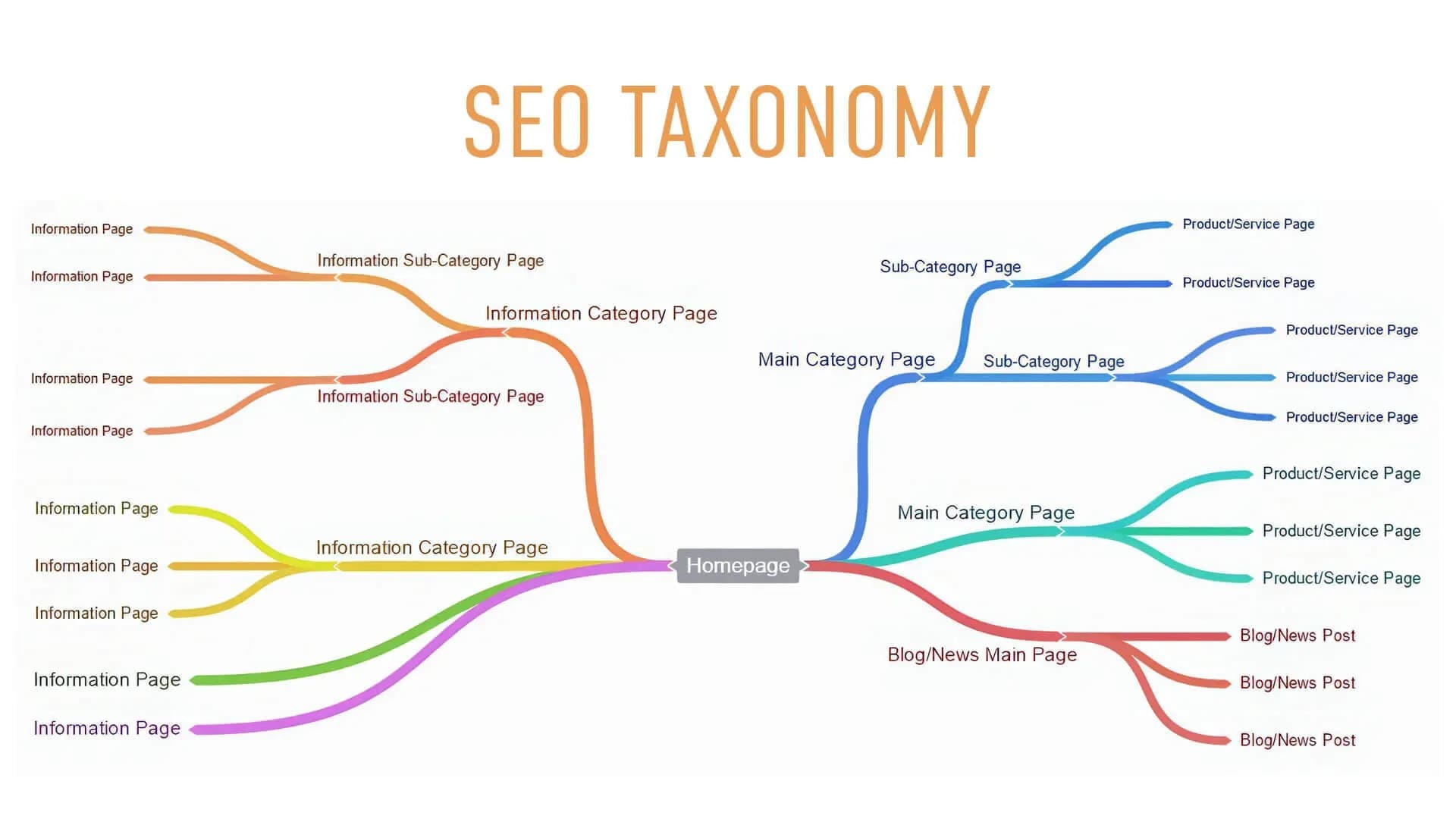
When your website taxonomy is implemented well, search engines and users can crawl your site efficiently, understand how pages relate. And better index them.
For users, taxonomy works like a quiet guide in the background.
If someone lands on a blog post titled “What Is Technical SEO?”, they should instantly see where they are in the structure:
Blog → SEO → Technical SEO
In case they want to dig deeper, they can click the “Technical SEO” category and find related pieces like Core Web Vitals, Site Speed Optimization, or Crawl Budget Optimization.
That simple logic (grouping related ideas under a clear hierarchy) can keep your content ecosystem tight.
Search engines understand context better, and users never feel lost.
Over time, that structure can result in stronger visibility, cleaner crawl paths, and a site that actually scales instead of collapsing under its own content.
How SEO Taxonomy Affects Crawlability and Indexing
Search engines rely on structure to understand which pages matter, how they connect, and how deep to crawl.
Your SEO taxonomy shapes that structure.
When the hierarchy is consistent, crawlers move smoothly through your site without wasting crawl budget on duplicates, unnecessary parameters, or low-value detours.
Each folder and link signals relevance and priority in a predictable way.
A category-level page often exposes the impact fastest because it sits at the intersection of filters, dynamic elements, content groupings, and user-driven interactions. Even a simple listing page can expand into several crawlable variations if the system doesn’t enforce clear boundaries:
- /women/sneakers?color=white
- /women/sneakers?size=7&color=white
- /women/sneakers?sort=price_low
- /women/sneakers?sort=newest&brand=nike

Multiply this pattern across a large site and crawlers end up looping through parameter-driven versions instead of consistently reaching the core pages that shape your visibility.
Vadzim Zubelik, Head of SEO at Ninja Promo, puts it clearly:
“Crawl efficiency tanks when duplicate categories, uncontrolled filters, and deep nesting create thousands of dynamic URLs left open for indexing.”
A strong taxonomy keeps that sprawl contained.
- It defines one controlled path for every product, article, feature, or listing and sets a stable structure for each parent category.
- It gives the crawler a direct route to follow instead of letting the system generate endless side paths.
- It sets boundaries for filters, sort orders, or dynamic components so they behave like view changes rather than new pages.
- It standardizes folder depth so sections, subsections, and individual pages follow the same pattern across the entire site.
- It also reinforces internal linking so the most important URLs receive the clearest signals.
For example, a well-structured taxonomy gives each category one authoritative URL:
/women/sneakers/
All filtered or sorted versions point back to this master page with consistent canonicals.
This creates a stable environment where crawlers can reach your key sections faster, index them more reliably, and revisit them often enough to keep performance steady.
Why Clear Taxonomy Improves User Experience
When users land on your site, they expect a sense of order. They want to understand where they are, what sits alongside it, and how to move deeper without second-guessing themselves.
A clear taxonomy gives them that orientation instantly.
It reduces cognitive effort by aligning your structure with the way people naturally browse and group information.
Imagine someone finishing an article on your site and wanting to read more.
They move their cursor to the navigation bar expecting one obvious place for your content. Instead, they hover and see multiple sections that all sound similar without any clear description:
- Blog
- Resources
- Guides
- Insights
The navigation feels confusing, which degrades the user experience. And we all know, UX affects SEO, which is why user experience optimization is important.
A clear taxonomy removes that friction.
In this case, it puts all editorial content under one category, uses predictable naming, and keeps every page aligned with the same hierarchy.
Semrush sets a strong example of getting this right.
Each content destination in the nav has a precise non-competing purpose.
Along with a clear description for each:

Visitors can easily find what they want because the structure reinforces their expectations instead of challenging them.
4 Types of SEO Taxonomies
Every high-performing website rests on a taxonomy system.
Across industries, these systems tend to follow four structural models. Each determines how efficiently search engines interpret content and how intuitively users move through it:
1. Hierarchical Taxonomy
A hierarchical taxonomy defines clear parent–child relationships between pages.
Each level narrows topical focus, forming a vertical flow of relevance.
Like this:
Broad Category → Subcategory → Specific Topic → Individual Page
✅Example:
Home → Blog → SEO → Technical SEO
This model provides stability and predictability.
For search engine crawlers, it clarifies which pages carry authority and how that authority passes down through internal links. For users, it creates orientation as every path has context and depth.
Hierarchical systems scale well for content-rich environments such as ecommerce catalogs, publisher archives, and technical documentation. When maintained properly, they make crawl paths efficient and ensure link equity flows according to intent, not accident.
2. Flat Taxonomy
A flat taxonomy removes depth entirely.
Each page exists directly under the root without subfolders or nested hierarchies.
✅Example:
www.abcd.com/about-us
www.abcd.com/services
www.abcd.com/contact
This structure favors crawl efficiency and speed.
Crawlers reach every page within one click, and users don’t have to navigate through layers to find what they need.
It’s the right choice if you’re doing SEO for a new website and especially if it’s small, or a standalone landing page.
3. Faceted Taxonomy
A faceted taxonomy organizes content by multiple attributes or filters, letting users refine results dynamically based on what matters to them. Like brand, price, color, or size.
✅Example:
An ecommerce site might let shoppers filter sneakers by:
/sneakers?brand=nike&color=black&price=under-10000
Each combination of filters creates a new view of the same core content. That flexibility makes navigation structure intuitive for users but tricky for SEO.
Because search engines see every variation as a potential new URL.
This model shines for large product catalogs or directories where users expect personalization and filtering.
But it demands tight technical control. For instance, use canonical tags, parameter rules, and robots.txt directives for wasted crawl budget and duplicate content prevention.
4. Network Taxonomy
A network taxonomy organizes content through contextual links instead of strict hierarchy.
Here, pages don’t belong to a single parent. Instead, they connect wherever relevance overlaps.
This system works best for blogs, documentation libraries, and educational hubs, where users might jump between related ideas instead of following one fixed path.
For crawlers, it strengthens semantic understanding (showing how topics relate across clusters) and builds link equity naturally across the site.
Where hierarchy creates order, a network taxonomy creates connection.
Both are essential, but for content ecosystems built on depth and relationships, the network model keeps everything discoverable and alive.

8 Best Practices for SEO Taxonomy Implementation
Implement these nine SEO taxonomy best practices:
1. Design a Logical Scalable Structure
If your structure only makes sense for your current content, it’ll break the moment you add a new product line, publish more blog posts, or expand into a new market.
That’s why designing a logical and scalable framework from day one is critical.
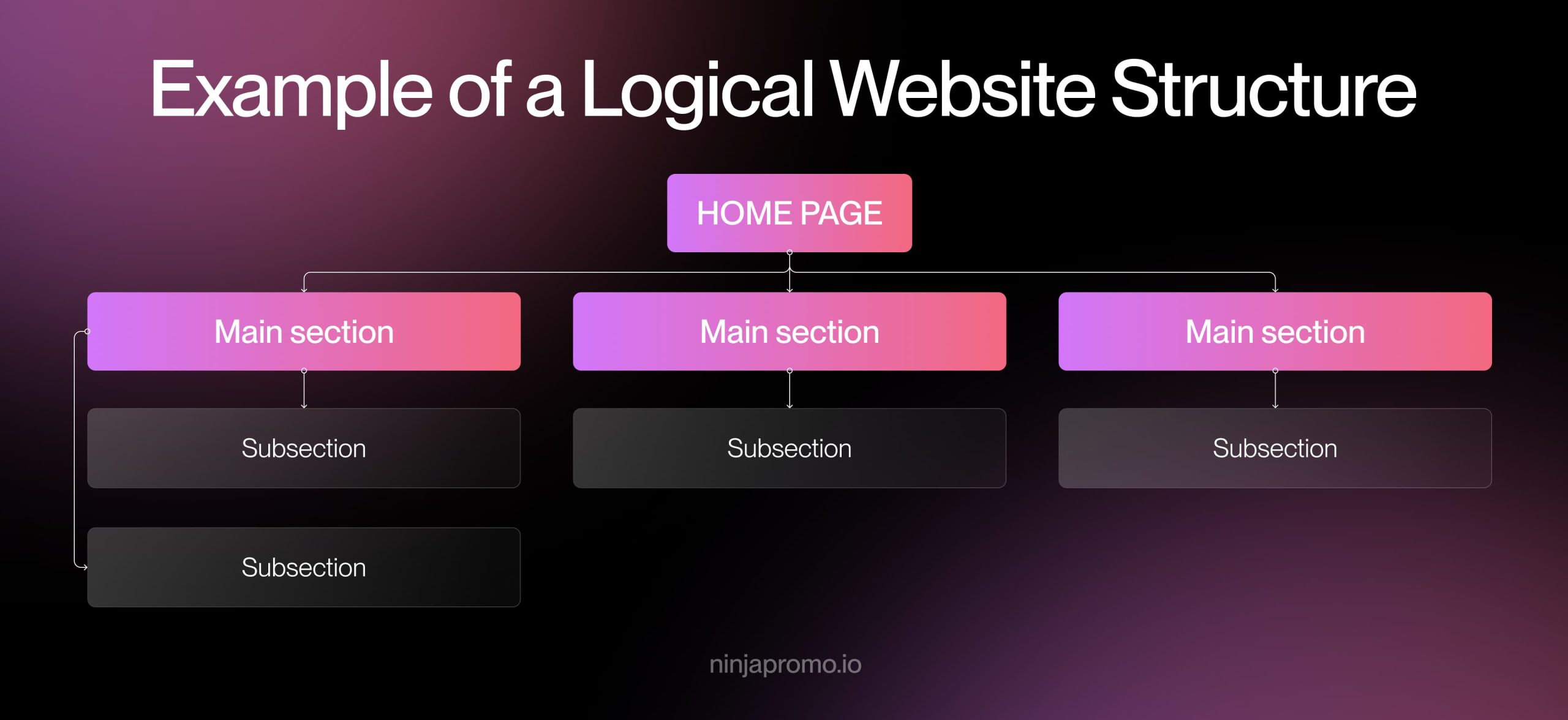
Every category, subcategory, and tag should exist for a reason.
Start by defining your core content pillars and mapping how subtopics fit under each.
For instance, if your main section is SEO, its subcategories might include:
- Local SEO
- Technical SEO
- On-Page SEO
- Off-Page SEO
Each branch should have a clear purpose and place in the hierarchy.
Avoid over-nesting or one-off folders. If a page is more than three clicks away from the homepage, it’s buried.
Keep the depth shallow and predictable so crawlers and users can move intuitively.
Vadzim Zubelik, Head of SEO at Ninja Promo, notes:
“Signs that a taxonomy has the potential for successful scaling include a flat and logical structure, clear and consistent intuitive navigation, and strong logical automated internal linking. Conversely, signals that a taxonomy may break include deep levels of nesting, the presence of pages without internal links, chaotic navigation, and disjointed or overlapping categories.”
Here are a few tips to design a logical scalable structure for your site:
- Start with topic and/or keyword mapping. Open a whiteboard tool like Miro and list your core themes alongside their subtopics. For instance, if your site focuses on the category Digital Marketing, your pillars could be SEO, Social Media, and Email Marketing, each branching into subtopics like Technical SEO, Instagram Strategy, and Automation Workflows.
- Keep hierarchy depth under three levels. No page should sit more than three clicks away from the homepage. So, flatten unnecessary folders to avoid deep crawl paths.
- Use clear descriptive names. Every directory should describe its contents with precision. Replace vague terms like /resources/ or /misc/ with intent-driven ones such as /how-to-guides/, /case-studies/, or /templates/. This can instantly clarify purpose for users and gives crawlers stronger topical signals.
- Make internal linking a structural habit. Follow a parent–child–sibling pattern. Parent pages should link down to related subtopics, subtopics should link back up, and sibling pages should cross-link where context overlaps.
- Future-proof your categories. Build a framework that can expand without breaking. If your current structure covers SEO and Content Marketing, leave space for future categories like AI SEO without renaming folders or URLs. Keep categories broad enough to accommodate growth while maintaining topical logic.
- Document your taxonomy rules. Maintain a shared taxonomy sheet that outlines everything.
2. Manage Taxonomy for Large-Scale Sites
Once a site crosses a few hundred URLs, taxonomy management stops being a content exercise and starts becoming infrastructure work.
At that point, every new category, tag, or filter can affect site crawl efficiency and link equity.
Also, revenue attribution.
The most common failure mode I’ve seen is taxonomy drift. That’s where teams creating new sections without rules:
- Marketing adds /resources/
- Product adds /insights/
- Engineering experiments with /content/.
Here, crawl paths overlap, and search engines can’t tell which version to trust.
In ecommerce, this chaos multiplies fast.
A single duplicate path like /women/sneakers/ and /sneakers/women/ might look harmless, but at scale it fragments authority and burns crawl budget on redundant pages.
Vadzim Zubelik, Head of SEO at Ninja Promo, explains:
“Long-term SEO scalability is determined by developing SEO principles—and adhering to them—regarding the depth of nesting levels, the logic of groupings, and the controllability of filters, already at the website design stage.”
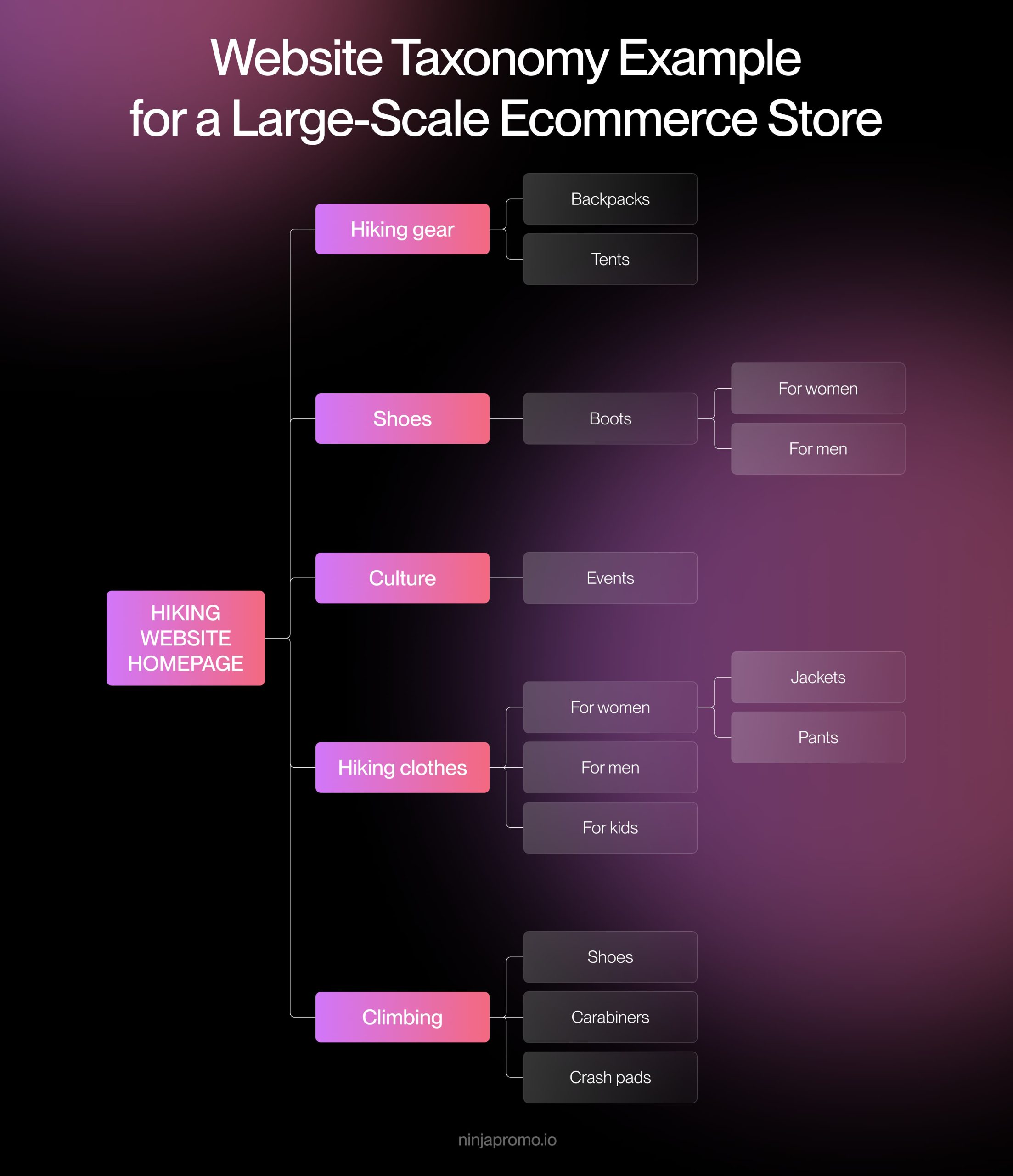
So, how to manage taxonomy at scale? Follow these tips:
- Create taxonomy governance rules. Document naming conventions, hierarchy depth, and who’s allowed to create new categories. This can prevent one-off folder creation that disrupts structure.
- Set up periodic taxonomy audits. Use tools like Screaming Frog, JetOctopus, or Botify to identify duplicate or orphaned category pages. Review internal linking depth every quarter.
- Use canonicalization and redirects consistently. When duplicate or similar categories exist, consolidate them under one canonical version. Redirect legacy URLs instead of leaving them live.
- Control dynamic URL generation. Ecommerce filters often generate thousands of low-value pages. Block unnecessary combinations using robots.txt, sitemap optimization, canonical tags, or noindex directives.
- Monitor crawl distribution. In Google Search Console, check Crawl Stats and Pages Crawled per Day. If you see heavy crawling on parameterized URLs or thin pages, your taxonomy likely needs cleanup.
3. Optimize Category and Tag Pages for Search and Avoid Thin Content
Category and tag pages are the connective tissue of your taxonomy.
They shape how both users and crawlers navigate your ecosystem. Yet they’re often treated like byproducts of a CMS instead of strategic entry points for search.
Poorly structured category pages can lead to thin, redundant, or orphaned content.
A /women/dresses/ page that only shows a grid of products with no intro, filters, or internal links can send the wrong signal to search engines: this section doesn’t matter. But when designed well, category pages become high-value hubs that concentrate authority, reinforce topical relevance, and guide both users and crawlers deeper into your site.
Imagine that same /women/dresses/ page with a short paragraph on seasonal trends.
Similar to this one:

That single layer of structure turns a passive collection into an active content asset.
Here’s how to optimize category and tag pages for search:
- Add a short content block at the top. Write 100–200 words explaining the theme of the category. Use 1–2 target keywords naturally.
- Avoid filter and tag bloat. Don’t create separate tags for every minor variation like “blue dresses,” “navy dresses,” and “royal blue dresses.” Keep filters structured and tags meaningful.
- Use canonical tags for similar categories. If both /women/dresses/ and /dresses/women/ exist, canonicalize one version to prevent duplication and crawl waste.
- Add schema markup. Use ItemList or BreadcrumbList schema to help search engines understand relationships between posts.
- Make category pages part of your linking strategy. Link from related articles back to category pages to signal their importance.
4. Implement Content Silos and Topic Clustering
When your site starts expanding across dozens of categories, silos and topic clusters become the glue that holds your taxonomy together. It’s the process of building structured “content ecosystems” that reinforce expertise within each topic.
This structure also strengthens topical authority, helping search engines and AI systems understand how your pages relate. And which clusters represent true depth on a subject.
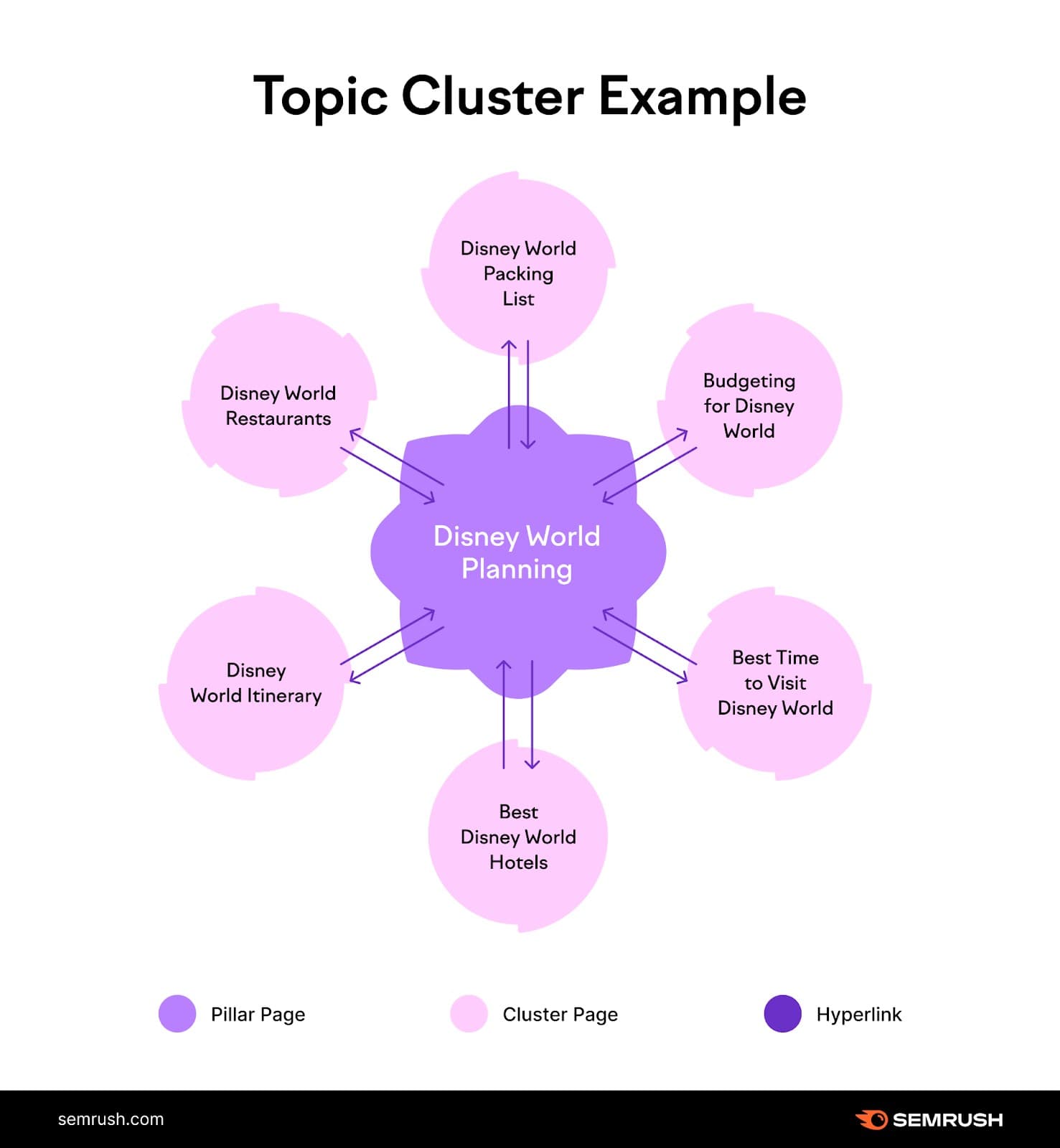
Imagine your blog’s SEO section.
You have a main hub page called /seo/, which explains the fundamentals.
Under it, you create focused subpages like:
- /seo/on-page-seo/
- /seo/technical-seo/
- /seo/local-seo/
Each one links back to the main SEO page and to each other, forming a closed loop of context.
This makes your SEO hub stronger and positions you as an authoritative source on the entire subject.
Instead of scattered posts competing for attention, you’re building a unified network where every page supports the next.
Here’s how to build effective silos and clusters:
- Create hub pages that anchor topics. Every major theme should have a central page that introduces the topic and links to its subpages. Think of it as your category’s ‘table of contents.’
- Keep interlinking intentional. Each subpage should link up to the hub and sideways to other related subpages. This creates a tight-knit cluster where authority flows naturally.
- Use breadcrumbs and contextual anchors. Breadcrumbs reinforce hierarchy visually for users and structurally for crawlers. Use descriptive internal anchors like “Learn more in our Technical SEO guide” rather than vague phrases.
5. Implement Strategic Internal Linking
Internal linking is the circulatory system of your taxonomy.
It connects pages, transfers authority, and tells crawlers which parts of your site deserve attention. Without it, even your best content risks becoming an isolated page lost in the crawl.

Strong internal linking does three things:
- It helps users navigate intuitively
- It helps search engines understand relationships between pages
- And it strengthens the authority of key pages by channeling link equity
Most content marketing teams treat internal linking as an afterthought.
But a deliberate internal linking strategy can dramatically improve crawlability and authority flow.
Follow these tips to build a solid internal linking architecture:
- Design internal linking before you publish. When building a new section, map out internal paths in advance — how the main hub connects to subpages, which pages cross-link, and where authority should concentrate.
- Control link dilution. Too many links on a page can blur importance. Hence, prioritize relevance over quantity. Each link should earn its place by serving context.
- Use anchors as strategic signals. Anchor text is metadata for both crawlers and users. Generic phrases like “click here” waste that signal. Replace throwaways like “read more” or “click here” with intent-rich anchors such as “guide to B2B content distribution” or “how to conduct a site audit.” Each anchor should hint at the value waiting on the other side.
- Feed link equity to your best performers. Regularly identify pages that convert, rank, or attract backlinks. Funnel authority toward them through internal links from related articles or category hubs. That’s how you build compounding visibility.
- Think like an editor. Great linking feels invisible. It guides the reader intuitively while quietly reinforcing structure for search engines. Every click should feel like the next logical step rather than a detour.
6. Use SEO-Friendly URL Structures
An SEO-friendly URL structure is a clean, descriptive, and logically organized format for your web addresses that mirrors the hierarchy and taxonomy of your site.
A well-structured URL can help search engines understand relationships between pages and crawl your site efficiently.
It also improves user trust and click-through rates.
Because people are more likely to click a result when the URL clearly matches their intent.

✅Example:
- /seo/technical-seo/core-web-vitals/ → communicates clear topical hierarchy
- /index.php?id=47&cat=seo → hides meaning and confuses crawlers
So, how do you build SEO-friendly URLs structure that scale cleanly, age well, and hold up under thousands of pages?
- Design URLs to reflect taxonomy. Each directory should represent a logical step in your site’s hierarchy. For example, /resources/templates/seo-audit-checklist/ tells Google exactly how the page fits within your structure. Avoid arbitrary folders like /v2/ or /content123/ that add no meaning.
- Prioritize consistency over creativity. Search engine crawlers reward predictability. Whether you use /blog/, /insights/, or /guides/, pick one and stick with it. Constant renaming or mixing conventions breaks internal coherence and creates redirect chains over time.
- Cut noise early. Avoid URL bloat — parameters, session IDs, or unnecessary words. Every extra element adds friction. /pricing-enterprise/ is cleaner and faster to interpret than /our-enterprise-pricing-options-page/.
- Use hyphens and lowercase. This is not cosmetic. /local-seo-guide/ is parsed correctly; /Local_SEO_Guide/ introduces case sensitivity risks across servers and tracking tools.
7. Leverage Schema Markup for Taxonomies
Schema markup is the connective metadata that translates your taxonomy into a language search engines fully understand.
When implemented right, schema makes your site information architecture explicit. Also, pages with markup from Schema have a 40% higher CTR than pages without it.
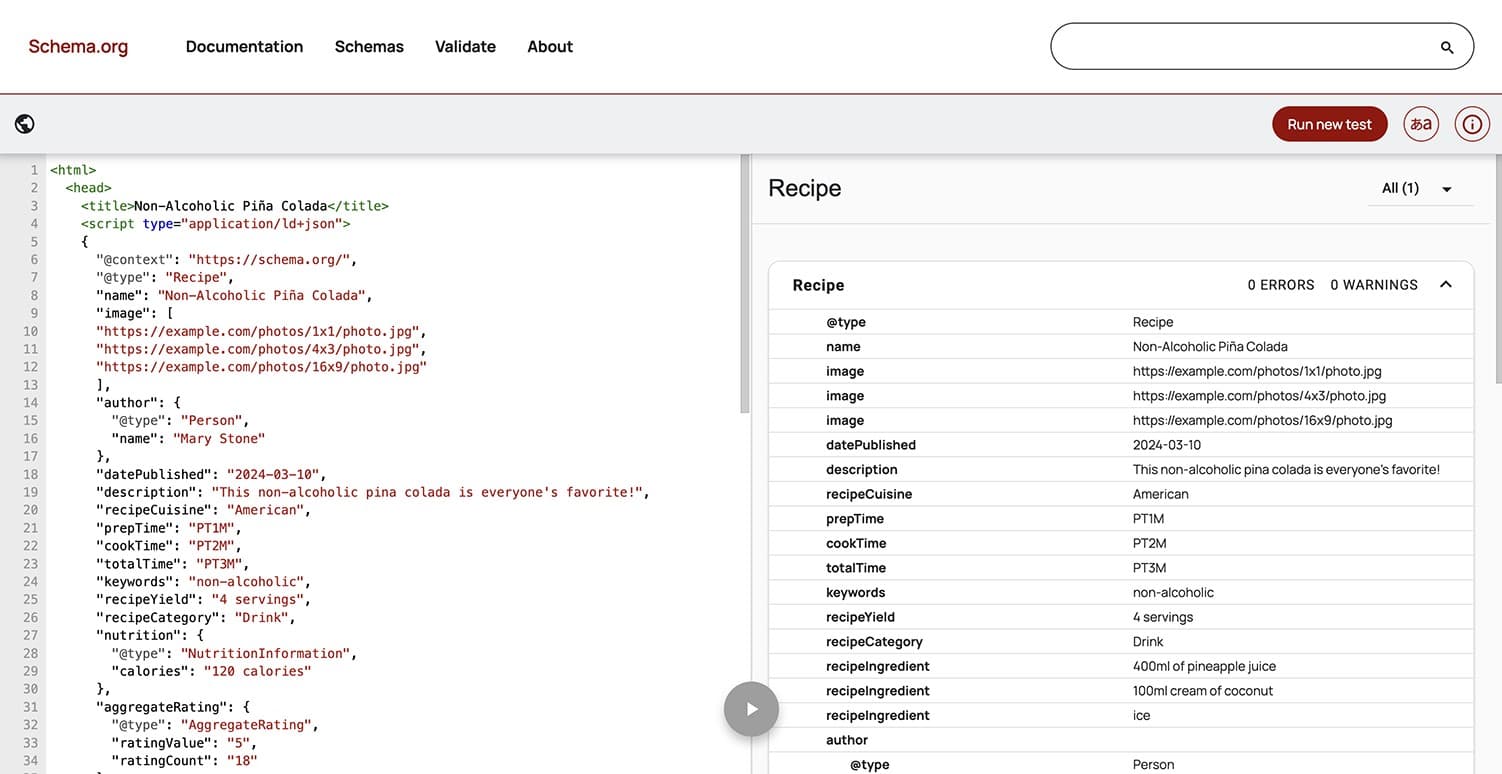
When implemented well, it can help search engine crawlers map a clear website hierarchy faster, improve rich result eligibility, and strengthen how your content is interpreted across AI search, Knowledge Graphs, and voice assistants.
How to apply schema markup to strengthen your taxonomy? Follow these tips:
- Use BreadcrumbList for hierarchy clarity. Breadcrumb schema reinforces your parent–child relationships. It shows search engines how categories, subcategories, and pages connect. This markup directly supports both structured navigation and rich snippets in SERPs.
- Add ItemList to category and hub pages. If your category page lists related articles or products, ItemList schema signals that it’s a collection of related items. This helps crawlers interpret context and rank those collections more confidently.
- Implement WebPage and Article markup consistently. Every page should declare what it is and how it fits within the taxonomy. For example, a blog post about “Core Web Vitals” should use Article schema, nested under a WebPage entity that references its parent section (/seo/technical-seo/).
- Validate and monitor markup regularly. Use tools like Google’s Rich Results Test, Schema.org validator, or Semrush Site Audit’s structured data report. Check for errors, nesting issues, or missing relationships that could break your structured hierarchy. And even improve site usability
8. Optimize for AI Citation and LLM Visibility
If your taxonomy isn’t built to help large language models (LLMs) understand your content hierarchy, your brand becomes invisible in AI-generated answers.
AI platforms don’t see your website like humans or even traditional search engine crawlers.
They parse context. This includes entities, topic depth, consistency, and how ideas interlink.
Your taxonomy is what teaches them those relationships.

Follow these LLM SEO taxonomy tips:
- Map entities. Every major category should correspond to a defined topic or entity. Make these relationships consistent across schema, internal links, and metadata.
- Keep taxonomy shallow, structured, and semantically consistent. LLMs value coherence. If your hierarchy mirrors how real users think, AI systems can follow the logic without noise.
- Prioritize clarity over cleverness. LLMs understand patterns over branding jargon. For instance, “/content-ai-generator/” is more interpretable than “/spark-lab/” or “/creative-engine/.”
- Measure your AI footprint. Use Semrush’s AI Visibility Toolkit or similar tools to see how often your brand surfaces in ChatGPT, Perplexity, or Google AI results.
Common SEO Taxonomy Mistakes to Avoid
Here are some common SEO mistakes to avoid in your taxonomy:
- Overly complex or shallow structures. Sites often swing to extremes: too many layers that bury key pages, or structures so flat that categories hold hundreds of unrelated items. Both patterns slow navigation and dilute relevance signals. A durable taxonomy balances depth and clarity so users and crawlers can move through the hierarchy without friction.
- Duplicate or overlapping categories and tags. When multiple sections describe the same topic, content gets fragmented across the site. Users bounce between near-identical paths, and crawlers treat each variation as a separate cluster. This can weaken authority, split internal signals, and leave category pages competing with each other instead of reinforcing one another.
- Weak internal linking that doesn’t reinforce the hierarchy. Internal links tell crawlers which sections matter most. When key category pages are buried, orphaned, or linked inconsistently, the entire structure loses strength. A well-planned internal linking system concentrates signals toward the primary categories and ensures every important page receives steady crawl attention.
- Inconsistent URL patterns across categories, subcategories, and pages. URL structures should reflect the site’s hierarchy. When paths jump between formats, expose random parameters, or hide their parent category, it becomes harder for crawlers to understand relationships across the catalog. Clean and predictable paths stabilize search engine indexing, reduce duplication, and make the taxonomy easier to maintain as the site grows.
- Taxonomy getting too deep or fragmented: Olivia G., SEO Specialist at Ninja Promo, warns that one of the earliest red flags is when large groups of pages fail to index or bring in meaningful traffic. She continues:
“In such cases, a thorough review is needed to analyze why these pages underperform, and they may need to be modified or removed if they continue to fail. Other signs include confusing category hierarchies, too many subcategories, and overlapping or redundant pages, which make the taxonomy harder for users and search engines to follow.”
Want Your Website to Rank Higher and Generate More Leads?
If this guide made one thing clear, it’s that weak taxonomy holds back everything else you try to improve.
If you need a team that can rebuild this foundation without disrupting your current workflows, Ninja Promo handles it end-to-end.
Our specialists handle taxonomy design, restructuring, and large-scale SEO architecture with the precision complex sites demand.










